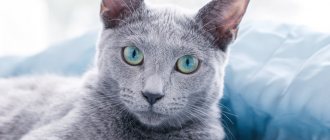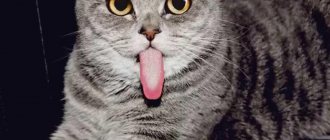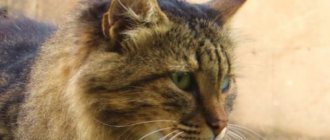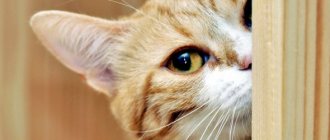Reasons for appearance
Cyanosis can give the skin or mucous membranes a bluish or reddish tint, this is due to a lack of oxygen or a decrease in hemoglobin.
Blueness can be caused by hereditary diseases, congenital heart disease, various respiratory diseases, and exposure to certain chemicals. Cyanosis in cats is usually a warning sign for owners and veterinarians.
The causes of melanocytic skin hyperchromia in cats are still unknown. But veterinarians associate this factor with heredity. It is known that there are cats predisposed to this phenomenon. In red individuals, dots are most common in the mouth, and they can be not only black, but also dark blue or dark brown. Regardless of color, the dots do not pose a danger and do not indicate internal disorders.
Why does language work this way?
The roughness of a cat's tongue is due to the need to easily grasp and separate pieces of food in the mouth. Meat and fish fibers quickly detach from the bones, which helped speed up the process of eating in the wild. The protruding ridges also make lapping easier as the liquid stays in the dimples and doesn't roll out.
To maintain body temperature, the cat needs to constantly keep its fur clean, prevent it from getting tangled, and remove the groin that forms in the undercoat. It is impossible to perform these manipulations with a smooth tongue or claws. A clean pet attracts fewer parasites and pathogens.
Language and symptoms
- A red or bluish tint to the tongue, gums, lips and skin may indicate blood disorders.
- Worsening or difficulty breathing
- Coloration of paw pads bluish or reddish.
When your cat develops cyanosis and you, not knowing what to do, are looking for advice on this topic on the Internet on forums, we recommend not to self-medicate or experiment on your beloved cat. The fact is that there are many reasons for cyanosis in an animal, and the consequences of your experiment may disappoint you and your family.
Although cats are speechless, a pet's language can tell a lot about her health. For example, a cat’s white tongue, covered with plaque, indicates problems with the gastrointestinal tract, intoxication, fever, and constipation. If the tongue itself turns pale, shock, anemia, vascular disorders, heart disease, and hypothermia are suspected. Yellow plaque - check the kidneys and liver. Grayish, brownish - lungs, intestines, stomach.
We suggest you read: What to feed a cat with kidney failure, choosing the right diet
An ulcer on a cat's tongue can form as a result of trauma - biting, stabbing with a twig, or scratching with a claw. Usually, when you can look into the mouth, the damage is easy to notice. In this case, it is enough to treat the wound with an antiseptic and ensure that the sore heals quickly. No improvement within two to three days - see a doctor. If there are several ulcers, stomatitis, a bacterial or viral infection is suspected - a reason for an immediate visit to the clinic.
Viruses, severe pain or fever are suspected if the cat is breathing heavily with its tongue hanging out. In this situation, it is important to carefully examine and feel your pet, measure its body temperature and, of course, consult a doctor immediately.
If your cat has spots, strange grooves, or pimples on his tongue, be sure to show your pet to the veterinarian. There are many reasons for changes in the color and structure of the surface of the tongue, from fungi and bacteria to all kinds of viruses and chronic diseases of internal organs. Without treatment, necrosis of a cat's tongue may begin - tissue necrosis at the cellular level, an irreversible process. In this case, part, or even all, of the language will be removed. And you will be very lucky if the tissue of the oral cavity is not involved in the process.
A black tongue in a cat may be a symptom of an acute deficiency of vitamin PP. Although more often the pet simply licked something colorful - a fur collar of a jacket, a belt, etc. Sometimes a cat gets dirty with something, and then, while licking itself, scares the owners with a tongue of an unnatural color: particles of the substance, licked from the fur coat, get stuck between the papillae, turning the pinkish tongue into black, blue, green or bright red. The latter, that is, a red tongue, may be the beginning of an inflammatory process or a sign of high blood pressure.
If the owner notices that a cat has been bitten on the tongue by a wasp - this usually happens when the pet gnaws out a caught wasp stuck between its fingers - action must be taken immediately. The tongue has many nerves and blood vessels. Poison that gets into tissue spreads quickly. If an allergic reaction (swelling) begins, the pet may die.
We suggest you read: It looks like sea water, but the water is fresh: setting up a pseudo-marine aquarium
To be on the safe side, you should give an intramuscular injection of diphenhydramine (or suprastin, but diphenhydramine is preferable). Dosage – 0.5 for a medium cat, 1 ml for a large pet weighing more than eight kilograms. Now all that remains is to observe your pet: if swelling still becomes noticeable, consult a doctor immediately.
What do scientists say?
The issue of cats’ perception of tastes and food has long been of concern to scientists from all over the world. For example, specialists from their Georgia Technological University determined that one of its secrets is located on the surface of the tongue. This organ is truly unique, in its structure and not only: this is the only way cats can survive during the heat, and also lick their cubs. Thanks to nipples on the tongue, cats are able to cool their body and apply more liquid to their fur.
The specialists also did a computer tomography and found that hollow-type capillary nipples can be different in size. There are much more of them in the central part, but they are smaller there. On the lateral parts they are larger, larger, but grow much less frequently. In the process of licking, cats use only those papillae that are located on the sides. This is how animals remove a quarter of excess heat outside the body without overheating in the heat. When you lick yourself, saliva evaporates and lowers your pet's body temperature. On average, cats can spend almost 3 hours in 1 day licking and using their rough tongue for its intended purpose.
Treatment
Treatment of this disease depends on the established diagnosis.
- Surgery is required for congenital heart disease.
- If hemoglobin is low, drug treatment is prescribed.
- For breathing problems that cause cyanosis and may be caused by pneumonia or chronic bronchitis, antibiotics are prescribed
- When fluid stagnates in the lungs, diuretics are prescribed.
- A thoracentesis (surgical procedure) is performed to remove fluid or air from the chest.
- Supply of oxygen when there is a shortage.
Pellagra
A disease caused by a lack of vitamin PP and B6 is called pellagra. In cats, this pathology is quite rare and is associated with a monotonous diet. In most cases, hypovitaminosis occurs in animals that eat low-quality dry food in a low price segment.
The composition of such feeds is not balanced and does not always meet the needs of the animal’s body for certain vitamins. Pellagra can also be encountered by street animals that do not have a regular diet and eat whatever they can find. Often cats taken from the street suffer from hypovitaminosis, and the owners cannot immediately understand the reason for the lethargy and drowsiness of their furry pet, as well as dark spots on the tongue.
Pellagra in cats appears as spots on the mucous membranes of the mouth, sometimes spots on the tongue, nose and ears. To make an accurate diagnosis, you should consult a veterinarian, since plaque in the ears and nose may be the result of tick-borne infestation, and spots on the tongue may turn out to be harmless pigmentation.
If the diagnosis is confirmed, treatment is carried out by adjusting the diet. It is recommended to purchase special vitamin supplements for cats, depending on the age of the pet. If the cat eats natural food, the following products should be introduced into the diet:
- liver;
- kidneys;
- sea fish;
- milk;
- carrot.
These products are rich in vitamin PP and quickly eliminate its deficiency. To achieve the best effect, it is necessary to combine a therapeutic diet with taking special vitamin supplements. The recommended dosage of vitamins PP and B6 is up to 5 mg per kilogram of pet weight.
Lack of vitamins
If a cat eats a monotonous diet, its body will quickly become deficient in the vitamins and minerals necessary for normal growth and functioning of its internal systems. The problem may arise if the pet's diet lacks foods such as:
- dairy products;
- fresh meat;
- sea fish;
- liver;
- vegetables, greens.
A similar situation can also occur due to a violation of the digestibility of foods by the digestive organs. Lesions of the gastrointestinal tract (for example, gastritis) will sooner or later appear in the form of black plaque on the pet’s tongue in the form of dots. Hypovitaminosis of vitamin PP (nicotinic acid) leads to disruption of oxidative and reduction processes within the body.
Functions
The functions of a cat's tongue are quite obvious. With its help, the animal takes care of itself by licking its fur. It also removes food debris from the mouth and face. We have all seen how a cat washes itself: after wetting its paw, it runs it over its face. These manipulations help cleanse it.
In addition, with the help of its tongue, the cat tastes the food offered to it and determines its temperature. If these criteria do not suit her, she will not eat the food you give her.
The peculiarity of the structure of the papillae of a cat's tongue provides it with the ability to drink water and liquid food. Running its tongue along the surface of the water, the cat lifts it, creating a trickle, which it drinks.
How to call a veterinarian at home?
What questions will need to be answered?
We invite you to familiarize yourself with: British marbled shorthair cat or “tabby”
In order to call a veterinarian, you need to:
- Call the operator at the numbers specified in the Contacts section;
- Tell what happened to the animal;
- Provide the address (street, house, front door, floor) where the veterinarian will arrive;
- Specify the date and time of the doctor’s arrival
Call a veterinarian at home and he will definitely help you. At home, as they say, walls can be healed.
Similar symptoms:
How to make grooming easier for your cat?
We use a hair comb and take care of this personal care product regularly. A similar approach is needed for cat tongue. Hair can get tangled between the hard papillae, which must be removed, otherwise it can cause serious harm to the health of your pet.
Much of the hair that a cat ingests comes out in feces or vomit. If stray hairballs remain in the gastrointestinal tract, the use of laxatives or even surgery cannot be avoided.
To prevent the animal from swallowing fur, it needs help in grooming itself. To do this, it is enough to regularly comb the cat’s body with a brush, removing dead hairs. Then it will be easier for felines to groom themselves without harm to their health.
Not all cats use such positive characteristics of their tongue. Lazy and overweight individuals prefer to be groomed by their owners, so they do not groom themselves. It is known that cats are more careful than cats; the latter are much less likely to use their rough tongue as a comb.
Glossitis
Superficial inflammation of the tongue, or its internal tissues, is most often a symptom of an internal disease. An inflammatory process in the mouth may result from:
- dental problems;
- damage to the tongue and the addition of microbes;
- infectious diseases;
- pathologies of the gastrointestinal tract.
The coating on the tongue takes on an unusual color. Such a symptom is quite valuable for establishing the real picture of the disease. Additionally, hypersalivation (increased salivation) and unpleasant odor from the pet’s mouth are noted.
Treatment should be aimed, first of all, at the root cause of glossitis. Because as an independent pathology, such a problem (inflammatory process in the tongue) is extremely rare.
A little anatomy
On the surface of the cat's tongue there are many capillary papillae - miniature keratinized sharp projections. They grow strictly towards the larynx, directed backwards. This arrangement also has a big disadvantage - since the papillae are directed inward and not outward, the cat is not able to spit out what gets on the tongue and gets caught. At the level of reflexes, the animal begins to swallow, and the object that gets on the tongue is swallowed even deeper, pushed into the pharynx, into the stomach. You've probably heard similar stories: a cat swallowed a thread and a needle and Christmas tree tinsel whole. Such “products” can lead to serious consequences, including death.
Rough capillary papillae are necessary for a cat to bring beauty - to lick and clean the thick fur. It is inconvenient to do this with claws, which is why such protrusions on the tongue work like a comb. In addition, when a cat licks itself, it also additionally combs out the fluff and undercoat. The tongue helps cats living on the street very well in obtaining food. The animal separates the meat from the bone well and, accordingly, eats more of it.
A cat's tongue is an organ of taste, a comb, soap, a spoon, a towel and many other useful things. The types of papilla may be different, for example, mushroom-shaped, slightly elongated. They contain taste detectors that help determine the taste of food. By the way, cats cannot detect sweet taste.
What to do and how to fix the problem?
If blue dots appear on your tongue or it turns white, you should immediately contact a veterinary clinic. A specialist will help determine the severity of the pathology and select therapeutic measures. Treatment is selected after a comprehensive examination. Thanks to this method, it is possible to assess the condition of the internal organs and find out the true reason for the blue tongue of the cat. The following diagnostic procedures are prescribed for the pet:
- laboratory testing of urine and blood;
- chest x-ray;
- ultrasound examination;
- analysis of the fluid contained in the sternum.
Air and fluid are usually removed from the animal's lungs during a simple operation.
Therapy is selected based on the diagnostic results and depends on the type of disorder that caused the cat to develop black spots on the tongue. If pneumothorax is detected, the specialist pumps out fluid or accumulated air from the sternum. The manipulation is performed after the pet has taken a small amount of the drug with a sedative effect. General anesthesia may often be required. A diaphragmatic hernia, which causes a cat to have a blue tongue, can only be dealt with through surgery. Surgery is prescribed when a hernial protrusion is detected in the early stages.
If a hernia in the diaphragm does not affect the general condition of the animal, then surgical intervention may not be performed.
The greatest danger to the health and life of a pet is pulmonary edema. To prevent the cat from dying, it is necessary to contact a veterinary clinic in a timely manner, where the animal will receive assistance. Treatment for pathology is carried out in a hospital setting, especially if symptoms of respiratory failure are recorded. After stabilization of the condition and elimination of the blue tongue and other signs of pathology, periodic prophylaxis is required to prevent recurrence of pulmonary edema.











